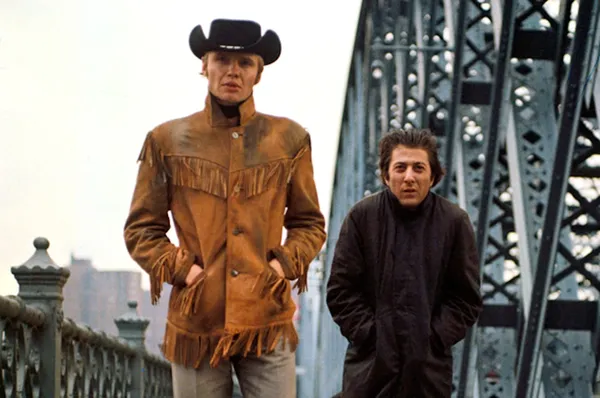 |
| Joe Buck (Jon Voight) with Ratso Rizzo (Dustin Hoffman) in John Schlesinger’s Midnight Cowboy |
In the second instalment with Nancy Buirski on Desperate Souls, Dark City And The Legend Of Midnight Cowboy (special advisor Martin Scorsese) we discuss Jon Voight as Joe Buck with the little girl reading a Wonder Woman comic, Jennifer Salt’s Crazy Annie and Sylvia Miles’s Cass in Midnight Cowboy. John Schlesinger with DP Adam Holender showing New York the way it really was, a Roberta Flack song and William Wyler’s adaption of Lilian Hellman’s The Children’s Hour, starring Shirley MacLaine and Audrey Hepburn, Nancy’s longtime cinematographer Rex Miller (A Crime On The Bayou, The Rape Of Recy Taylor, Afternoon Of A Faun: Tanaquil Le Clercq, The Loving Story), Far From The Madding Crowd and Vietnam, Brian De Palma on Dennis Hopper and the “international invasion”, and screenwriter Waldo Salt also came up.
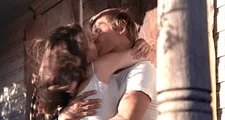 |
| Nancy Buirski on Crazy Annie (Jennifer Salt) with Joe Buck (Jon Voight): “Many of the women in Midnight Cowboy are treated as sexual objects, but his first love is a woman who’s not that.” |
“I see by your outfit that you are a cowboy” is a line from The Streets of Laredo, the song chosen over the end credits of Desperate Souls, Dark City And The Legend Of Midnight Cowboy (and featured prominently in Wes Anderson’s Asteroid City). Cowboys and outfits, kind words and life-saving deeds in a violent time make us reflect and associate the in-between. The evocative, wide-ranging, and evermore timely documentary drops us off at the start with Jon Voight telling the story of his encounter with Schlesinger in full self doubt at the end of shooting Midnight Cowboy. “What have we done?” he remembers the director questioning. To calm him down, the actor called it a masterpiece “that will outlive us.” Voight in present time tears up.
From New York City, Nancy Buirski joined me on Zoom for an in-depth conversation on Desperate Souls, Dark City And The Legend Of Midnight Cowboy.
Anne-Katrin Titze: I’d like to talk about the clips you chose early on about Joe Buck’s arrival in New York: The little girl on the bus reading the Wonder Woman comic, next we see him being taller than everybody else walking on the street, and then the corpse, or presumed corpse, the dead man in front of Tiffany’s. These choices of clips are so well thought through! Was that also like a conversation that you picked these?
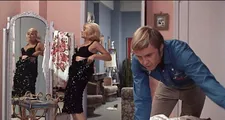 |
| Nancy Buirski on Cass (Sylvia Miles) with Joe Buck (Jon Voight): “The women are more complicated than a lot of people think they are in the film.” |
Nancy Buirski: Yes! We do that very carefully; there’s not a beat in the film that isn’t thought through. Even though I don’t write it down and I don’t plan ahead of time, there’s nothing that’s accidental. There are happy accidents but there’s nothing that isn’t thought out. First of all the little girl - the connection that he makes to her is so sweet. You really do see Joe Buck’s sweetness.
And she’s reading a Wonder Woman comic book! It’s a signal to us that women are going to be treated in an interesting way. Because many of the women in Midnight Cowboy are treated as sexual objects, but his first love is a woman who’s not that. That’s Crazy Annie, played by Jennifer Salt. So it is kind of complicated. And by the way, they may be sexual objects to Joe Buck, they’re not sexual objects to themselves because they push back on him and they don’t just let him do what he wants to do. Sylvia Miles asks him for money, not the other way around. So the women are more complicated than a lot of people think they are in the film. But the reason I love that moment is really Joe Buck connecting to that little girl.
The man on the street who appears to be dead, is a very important signal, I think, to our viewers that we’re going to be dealing with some pretty important and serious issues. And issues that we are dealing with today. I mean, homelessness is a major crisis in New York, in L.A., and all over the country. And it’s a reminder that it didn’t just start today. We were dealing with homelessness in the Sixties and we really haven’t solved this problem of poverty and economic disparity. It’s ongoing. It was fascinating that John Schlesinger focused on that. Again, being in another place it was much more apparent to him. That’s a very important aspect of our film.
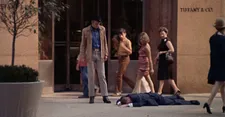 |
| Joe Buck (Jon Voight) crosses paths with a body in front of Tiffany & Co. |
AKT: It again also opens up into so many different things. It’s in front of Tiffany’s, and at the same time you can’t help but think of descriptions of the Warsaw Ghetto where people were walking past corpses on the street. And here you are, in the middle of New York. It moves into the past and into the present simultaneously.
NB: True.
AKT: Your choices of clips I found at times stunning, at others quite funny. Let’s start with the one where I had my hands in front of my eyes, which is Far from the Madding Crowd and the sheep scene and the dog - which I believe was the reason why this film was such a flop. It’s very hard to watch and you elegantly connect it with corpses strewn.
NB: Yes, and violence! And we moved very quickly into trying to look at what is going on in this country and Vietnam. So that’s the connection we’re making in a way. These needless deaths, these corpses, these sheep - it is hard to look at. But for too many people it was easier to not think about the people we were murdering in Vietnam.
And yet the world woke up to the injustice of that and really started to pay attention and to question it. That leads into another important theme in the film. All these things are kind of woven together but the whole idea that our society, and young people in particular, are starting to question and push back and become subversive in a way. Without that in the air, I don’t know if Midnight Cowboy would have been made.
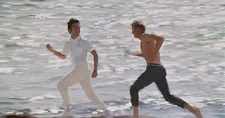 |
| Ratso Rizzo (Dustin Hoffman) running on the beach in Miami with Joe Buck (Jon Voight) |
AKT: Probably not. After we see Brian De Palma speak, there comes what I thought was a funny choice of clip. He talks about how it all started with Dennis Hopper and then the “international invasion” and you decided to go with the clip from Rosemary’s Baby, the one where she is about to see the baby. I thought for the first time, ah, the films coming out at that time are the devil’s baby!
NB: Thank you for helping me see that! I don’t know if I had gotten to that. But that’s what this film allows you to do, to have these conversations. And finding these metaphors and symbols in all of these films that become more so when you put them in the context of Midnight Cowboy.
AKT: Right! Embrace the devil’s baby! As you said, everybody is savable. That goes for the devil’s baby too! The third clip choice I wanted to mention is from The Children’s Hour. You show us Audrey Hepburn crying without really clarifying the context, which is beautiful, because it comes back later on. We get the explanation of what William Wyler’s film meant at the time in ’61.
NB: Thank you! We first had more information about that film in our cut and we were torn. There were some people who wanted it better explained. All you see is [Shirley] MacLaine’s body, the shadow of her legs, hanging at the end of that scene. I don’t know if you remember that, but we see Audrey Hepburn crying and then she opens the door and she sees her lover who has killed herself.
 |
| Jon Voight's Midnight Cowboy screen test |
And all you see is the shadow of her legs. I felt that was so powerful on its own, particularly with the music behind it. It’s Roberta Flack singing Ballad of the Sad Young Men. The whole chapter uses the song as its background and it ends on that scene. It’s a favourite of mine, frankly.
AKT: I noticed your DP is Rex Miller. Is that the Rex Miller of Citizen Ashe?
NB: Yes!
AKT: I spoke with him about Citizen Ashe. Do you play tennis with him?
NB: No I do not! I used to live in Durham, North Carolina and that’s where we met. He shot almost all of my films. Actually going back to The Loving Story. He even worked on Afternoon of a Faun. He’s been involved in all my films in one way or another and he’s a very good friend as well.
AKT: Please send my greetings to him!
NB: I will.
AKT: Bob Balaban calls Midnight Cowboy the first movie that looked like New York, that didn’t look like Easter Parade with Judy Garland and Fred Astaire promenading on Fifth Avenue. Do you agree?
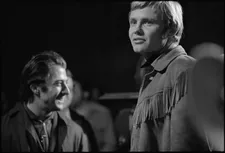 |
| Dustin Hoffman and Jon Voight on the set of Midnight Cowboy |
NB: Yes! Well, that’s one of the other things that made Midnight Cowboy so distinctive, that we were dealing with an era where audiences were eager for something more realistic. And John Schlesinger was the right person at the right time. He showed New York the way it really was; he showed it in all its grittiness.
Remember, John Schlesinger was originally a documentary filmmaker, so he’s very observational in his approach. He’s working with a DP, Adam Holender, who is also, I wouldn’t say cinéma vérité, but gives a documentary feel when he shoots. They shot with as much available light as they could, and wanted to make it feel real. I think we make the case in our film that they needed to do that and audiences needed to see that.
AKT: I also want to mention the wonderful Waldo Salt and Jennifer Salt combination and a great freeze of Senator McCarthy next to Roy Cohn! A nice archival combination!
NB: Yes, the Waldo Salt story, we could have done a whole documentary on that. You know, this was the first film he wrote after he’d been blacklisted for eleven years. John Schlesinger took a chance on him, too, again understanding the value of embracing someone who had had that kind of adversity and who is Other in a sense. There are a number of desperate souls in our film. Hence the title.
Read what Nancy Buirski had to say on The Streets Of Laredo, Western mythology, John Schlesinger the Other, costume designer Ann Roth, Lucy Sante’s observations, John Wayne representing old Hollywood, and the appeal of Jon Voight’s Joe Buck and Dustin Hoffman’s Ratso Rizzo.
Desperate Souls, Dark City And The Legend Of Midnight Cowboy is in cinemas in the US.





















